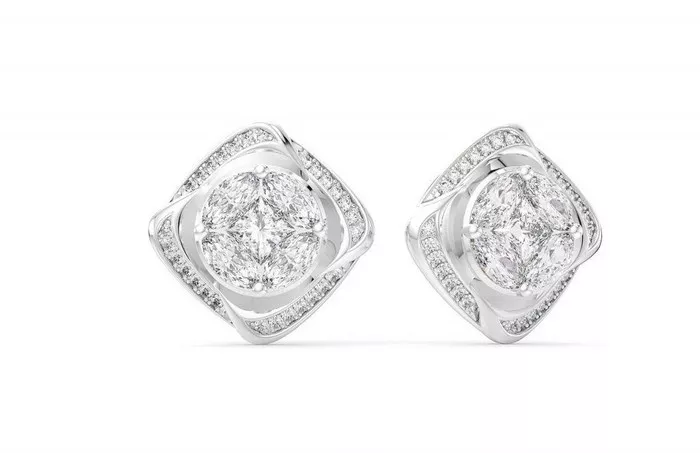In the realm of engagement rings, few decisions are as crucial or as defining as selecting the diamond cut. Beyond the 4Cs—cut, color, clarity, and carat weight—the diamond’s cut stands out as a key factor influencing its brilliance, sparkle, and overall appearance. This article delves into the intricate world of diamond cuts, exploring various popular options and offering insights to help you make an informed choice for that symbol of everlasting love.
Understanding Diamond Cut: The Basics
The term “diamond cut” refers not to the shape of the diamond (such as round, princess, or pear) but rather to its proportions, symmetry, and facets—the tiny, polished surfaces that reflect light and give the diamond its sparkle. A well-cut diamond will maximize its interaction with light, enhancing its beauty and perceived value.
Anatomy of a Diamond Cut
Facets: These are the flat, polished surfaces on a diamond that allow light to enter and reflect back, creating sparkle.
Proportions: The angles and relative measurements of a diamond’s facets, including the table (the flat top surface), crown (upper part), girdle (outer edge), pavilion (bottom part), and culet (bottom tip).
Symmetry: Refers to the alignment and balance of facets relative to each other. Symmetrical diamonds tend to have better light performance.
Popular Diamond Cuts for Engagement Rings
Diamonds come in various cuts, each with its unique characteristics and appeal. The choice of cut often reflects personal preference and style, as well as considerations of brilliance and fire. Here are some of the most sought-after diamond cuts:
1. Round Brilliant Cut
The round brilliant cut diamond is the most popular choice for engagement rings, prized for its exceptional sparkle and timeless elegance. It features 58 facets carefully positioned to maximize light return, making it the benchmark for brilliance.
2. Princess Cut
The princess cut is a square or rectangular-shaped diamond with pointed corners. It combines the brilliance of a round diamond with a modern, geometric shape, offering a contemporary alternative to traditional round cuts.
3. Cushion Cut
The cushion cut is a classic choice characterized by its rounded corners and larger facets, which enhance its brilliance and soft, romantic appearance. It has gained popularity for its vintage charm and ability to showcase the diamond’s clarity.
4. Emerald Cut
The emerald cut features a rectangular shape with step-cut facets that create a hall-of-mirrors effect. Known for its understated elegance and clarity, this cut emphasizes the diamond’s purity and pristine crystal structure.
5. Oval Cut
The oval cut diamond is a modified brilliant-cut with an elongated shape that flatters the finger and creates a larger surface area than a round diamond of similar carat weight. It offers a unique blend of brilliance and sophistication.
See Also: Is Wearing a Diamond Lucky?
6. Marquise Cut
The marquise cut is characterized by its boat-shaped silhouette with pointed ends. It is designed to maximize carat weight, giving the illusion of a larger diamond, while its elongated shape flatters the finger and creates a slenderizing effect.
7. Radiant Cut
The radiant cut combines the elegance of an emerald cut with the brilliance of a round cut. It features trimmed corners and faceting that maximizes the diamond’s sparkle, making it a popular choice for those seeking a dazzling yet distinct shape.
Factors Influencing Diamond Cut Choice
1. Personal Style and Preference
Your personal taste and style play a significant role in choosing the right diamond cut. Whether you prefer classic elegance, modern sophistication, or vintage charm, there’s a cut that aligns with your aesthetic.
2. Brilliance and Sparkle
Different cuts exhibit varying levels of brilliance and sparkle. Round diamonds are renowned for their exceptional sparkle due to their precise faceting, while step-cut diamonds like emerald and Asscher cuts emphasize clarity and elegance.
3. Finger Shape and Ring Setting
Consider how the diamond cut complements your finger shape and the overall design of the engagement ring. For example, elongated cuts like oval or marquise can visually elongate the finger, while round or princess cuts offer versatility in various ring settings.
4. Budget Considerations
While round brilliant cuts tend to be more expensive due to their popularity and precise faceting, other cuts like princess or cushion cuts can offer a similar brilliance at a potentially lower cost per carat. Balancing cut quality with budget constraints is crucial.
Evaluating Diamond Cut Quality
Understanding the quality of a diamond cut involves assessing its proportions, symmetry, and polish, often detailed in a diamond’s grading report. Key factors to consider include:
Cut Grade: GIA (Gemological Institute of America) assigns cut grades ranging from Excellent to Poor, evaluating the diamond’s light performance based on proportions and symmetry.
Light Performance: A well-cut diamond will reflect light internally from one facet to another and emit it through the top, creating sparkle. Poorly cut diamonds may leak light through the bottom or sides, appearing dull.
Optical Effects: Fire (dispersion of light into colors), brilliance (white light return), and scintillation (sparkle and pattern of light and dark areas) are crucial optical effects enhanced by a diamond’s cut.
Customizing Your Diamond Cut Choice
In some cases, you may opt for a custom diamond cut to achieve a specific look or enhance a unique setting. Working with a skilled jeweler or diamond cutter can help create a bespoke diamond cut that meets your exact preferences and specifications.
Conclusion
Choosing the best diamond cut for your engagement ring involves a blend of personal style, budget considerations, and understanding the technical aspects of diamond cutting. Whether you prefer the timeless brilliance of a round cut, the modern allure of a princess cut, or the vintage charm of an emerald cut, each diamond cut offers its own distinct beauty and appeal. By considering these factors and exploring various options, you can confidently select a diamond cut that symbolizes your enduring love and commitment—a reflection of your unique journey together.

